Cattleya is a numerous genus from the Orchid family, whose epiphytic and lithophytic plants were brought to Europe in the 19th century and immediately fell in love with flower growers. Cattleya orchid captivates with its beauty, grace and unsurpassed aroma.
Material Content:
Description of the genus and variety
The genus has about 40 hybrid varieties. A distinctive feature of the representative of the Orchidaceae family is a peculiar lip shape - a wayward petal of a flower, contrasting with the rest. As they grow older, the original plants grow in diameter due to the development of new shoots next to the old ones. Stems develop from pseudobulbs, which contain moisture and nutrients necessary for growth. During the flowering period, which lasts about a month, 10 fragrant flowers with a diameter of 25 cm are noted on one plant.
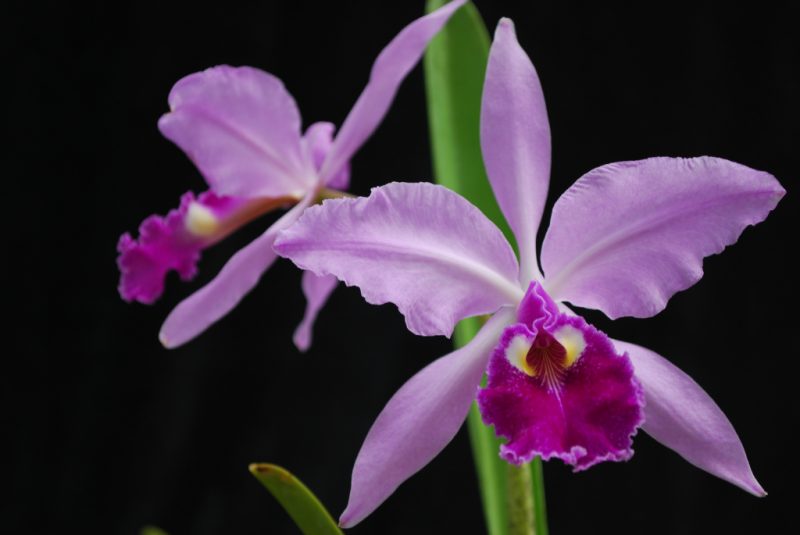
Thanks to the continuous work of the sectioners, more than 1000 varieties have been bred today, among which the following are especially popular:
- Catleya is two-colored - a plant with a height of up to 60 cm and small reddish flowers, whose lips are painted in purple.
- Triana - a half-meter Cattleya white with a pinkish tint and a bright crimson lip.
- Bowring is a pink-purple variety whose lip contrasts due to a yellow spot on a purple background. The diameter of the flowers does not exceed 7 cm.
Optimal conditions for growing a flower

In order for the Cattleya orchid to please the florist with beautiful and long flowering, it is necessary to create certain conditions for the flower.
Lighting

The flower loves the sun's rays and will be grateful for its placement on the windowsills of the east or southwest windows. A pot with a representative of the tropical flora can be installed even near the southern windows with the condition of shading at noon. The deficiency or excess of light is signaled to the grower by leaves, which, when deficient, become dark green, and in case of excess, light green.
Temperature
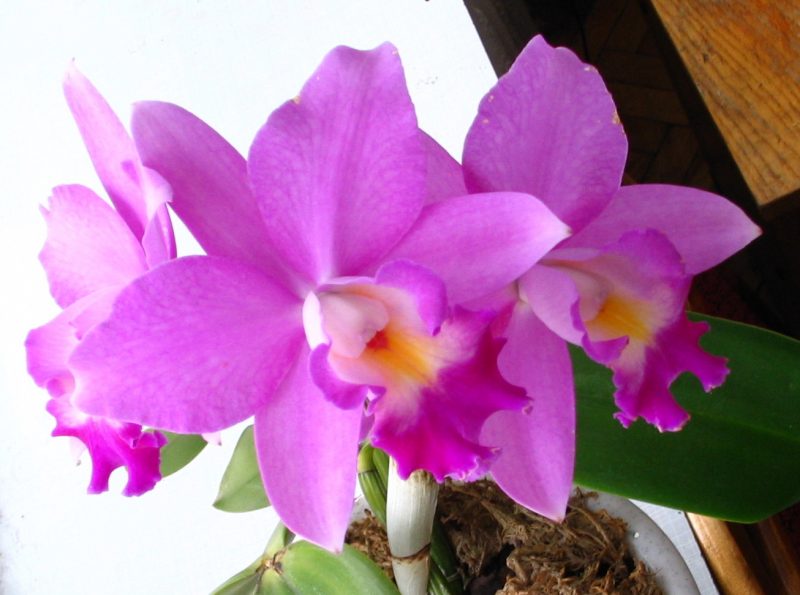
The orchid feels comfortable at ordinary room temperatures. However, in preparation for flowering, the plant needs temperature differences between night and day values in the range of 5-7 °.
Humidity
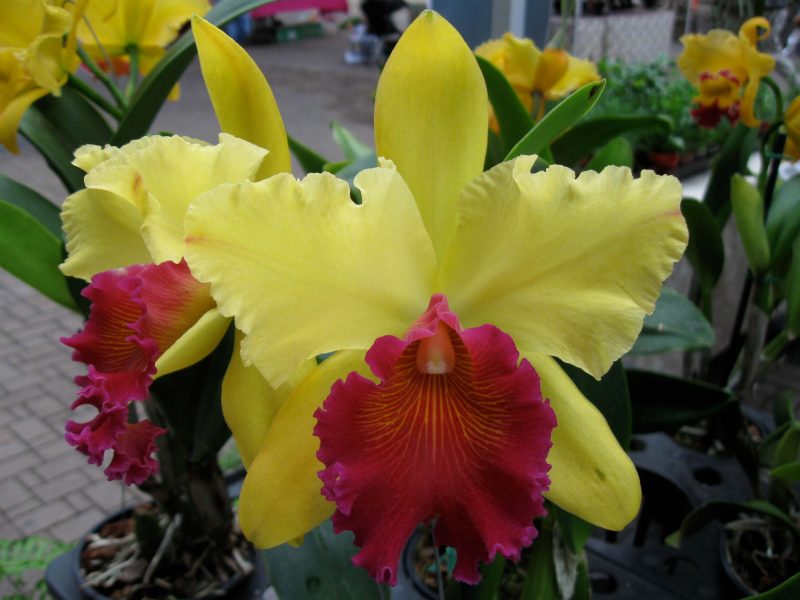
The bred varieties are not demanding on humidity and cope well with the dryness of room air. However, in hot periods, the flower likes to be in a pan with water, where it lowers the air roots. Every month during the period of active vegetation, it is recommended to organize a warm shower.
Cattleya Orchid: Home Care
Cattleya orchid is demanding for care. He must be competent and comprehensive.
Watering
Watering the substrate is necessary as it dries. With the onset of the dormant phase, watering is reduced. When the growing season resumes, the substrate should be sprayed with a spray gun. Normal irrigation mode resumes only after the beginning of the growth of the peduncle. When watering, you should be careful not to allow water to get on the shoots, which can lead to the appearance of dark spots. Water procedures are carried out with settled or filtered water.
Caution! Do not allow water to enter the growth center: this will cause rotting of the roots and death of the flower.
Fertilizing and fertilizers
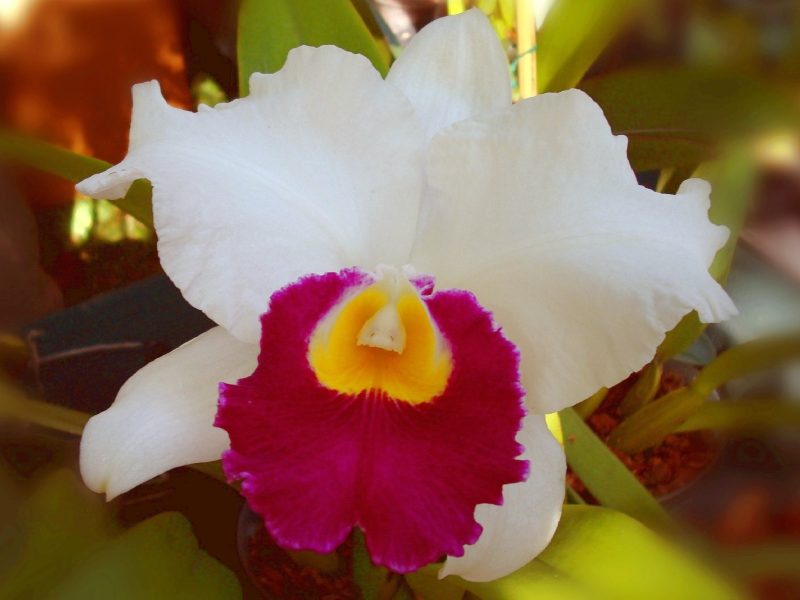
Orchid should be fed during the development period of the pseudobulb, the termination of which signals the stop of the procedure. After the appearance of the peduncle, fertilizing resumes and continues until the onset of the flowering phase. The substrate is enriched with phosphorus and potassium in a minimum concentration.
The nuances of landing and transplanting
Orchid transplantation is carried out only due to exhaustion and acidification of the substrate every 3-4 years: the flower is quite painfully undergoing a procedure carried out even by transshipment.
It is recommended to transplant the plant when new shoots reach a height of 3 cm, according to the following scheme:
- Clay pot is selected.
- A fresh substrate is prepared in equal parts from a previously soaked bark of small and medium fractions, as well as moss-sphagnum in equal parts.
- A thick drainage layer of expanded clay is laid at the bottom of the tank, which is covered with large pieces of bark and polystyrene.
- Next is an orchid, the roots of which are sprinkled with a finer bark mixed with moss.
Protection against diseases and pests

Cattleya orchid flower can be attacked by harmful insects with unfair care:
- Aphid - a microscopic sucking pest, which should be combated with a soap shower.
- Shield - insects that feed on the sap of the plant like dry air. To get rid of the pest, it is enough to remove it with a toothbrush from the shoots, and then increase the humidity near the flower.
- Spider mite - Another harmful insect that populates an orchid with a low level of humidity. To control the pest, you can resort to spraying with insecticides according to the instructions indicated on the package.
- Nematodes - worms damaging all parts of an orchid. Fighting parasites is very difficult. You should resort to spraying the substrate with a pesticide, and also organize the flower at an elevated temperature regime.
Dry air contributes to the blackening of leaf tips. Among diseases, root rot most often occurs, the development of which is associated with systematic overflows. You can save the orchid in the early stages by removing the affected roots and transplanting into a fresh substrate and pot.
How to propagate a cattleya orchid
To multiply the original flower from the tropical zone, the bush division method is used, which is usually associated with a transplant.
During:
- An earthen lump with the root system is removed from the pot and placed in a basin of water.
- After half an hour, when the substrate softens, the roots are gently released by hand with its residues.
- Water is being renewed.
- In clear water, the roots are disassembled and inspected.
- Damaged, rotten and dry roots are trimmed with a sharp sterile tool.
- Places of cuts are powdered with crushed wood or activated carbon.
- The treated root system is dried in a warm place, and then divided into parts, each of which should have at least 3 pseudobulbs and more roots.
- Damage is sprinkled with an antiseptic, after which the delenki are planted in prepared containers with a special substrate.
How to grow roots
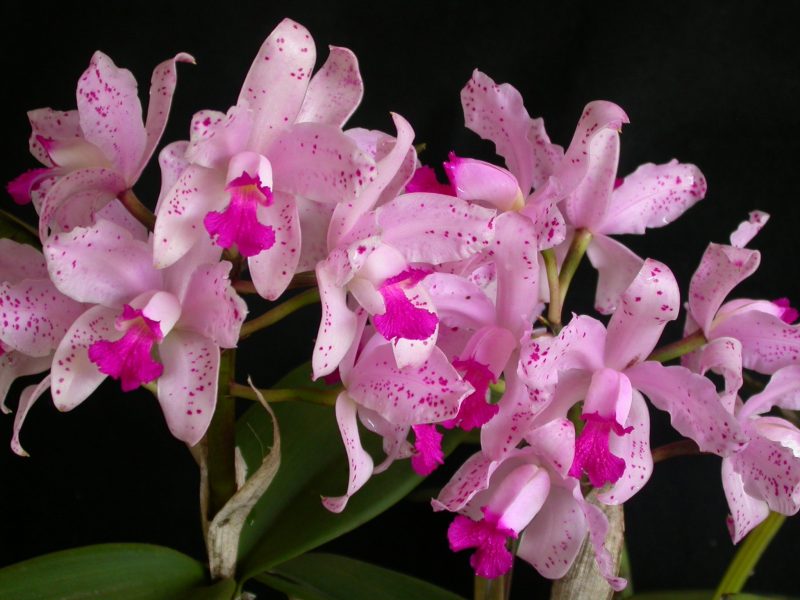
As a result of gray rot or old age, the orchid can remain without roots. In such a situation, it is necessary to quickly revive the flower and grow new roots. To do this, the plant is placed in a bowl of water so that only the rhizome is in the liquid. The plant is aged in water for about 2 hours. The procedure is repeated daily for a month. You can also use another method in which the orchid is placed in a bowl with expanded clay and moss, and then covered with a film to create greenhouse conditions. The film should be systematically removed for ventilation and moisturizing.
Thus, if a gardener wants to become the owner of a blooming Cattleya orchid, he should study all the nuances of growing a flower and strictly observe the care recommendations. A flower for care and attention will repay a beautiful and fragrant flowering.












